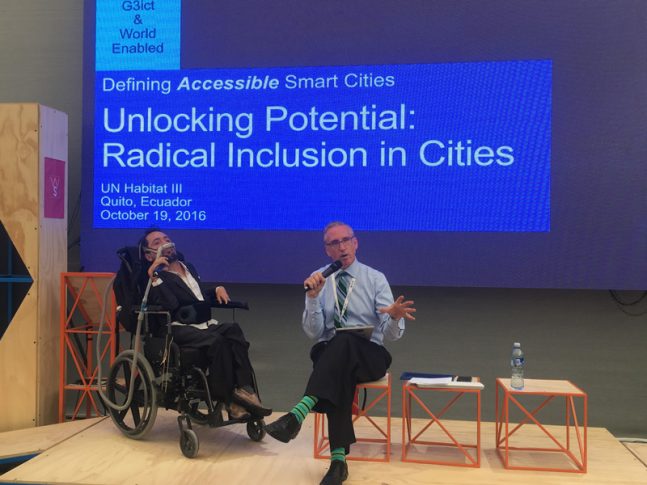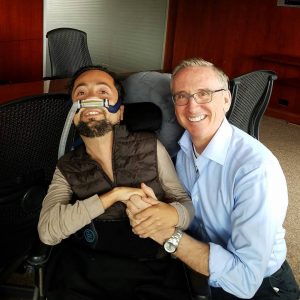Are smart cities failing the disabled and elderly?
24th October 2017 Jonathan Andrews
Dr Victor Pineda, President of World Enabled, and James Thurston, G3ict’s Vice President for Global Strategy and Development
During Smart Cities NYC 2017, a new toolkit, Smart cities for all, was released to help cities reduce the digital divide and make them accessible for all. Jonathan Andrews spoke to Dr Victor Pineda, President of World Enabled, and Co-Chair, Persons with Disabilities, on the General Assembly of Partners, the civil society body designed to help governments implement Habitat III. He was joined by James Thurston, G3ict’s Vice President for Global Strategy and Development
From the survey and data analytics that make up the toolkit, which are the leading cities in terms of reducing the digital divide?
Thurston
The survey data does not quantify specific cities in terms of their commitment to ICT accessibility and addressing the digital divide. However, the survey of more than 250 experts worldwide does tell us that 60 percent of them feel that smart cities today are failing persons with disabilities and older persons. More specifically, only 18 percent of the experts were aware of a smart city that is using ICT accessibility technical standards today.
What were the most surprising findings from the survey and analytics?
Thurston
For me, the most surprising finding was that the global experts did not list technology solutions as a top barrier to making progress on digital inclusion in smart cities. They know that smart city solutions exist and through innovation and entrepreneurship even more are possible, including those that could have a big impact on persons with disabilities and older persons.
What global experts don’t know is how to find and deploy those solutions. As part of our new toolkit, we have created the smart cities for all database of solutions for digital inclusion to help solve that very problem. With the database, now in Alpha version, we want to show that smart cities solutions have the potential to impact persons with disabilities and older persons in a broad range of ways–from supporting independent living, to helping with transport and mobility, to responding to natural disasters and emergencies.
Pineda
For me the research confirmed that the biggest barrier to making a city’s digital services accessible is the lack of awareness, not the costs associated with making a website accessible. For example, experts confirmed that it doesn’t necessarily cost a city more money to build an accessible website or provide accessible online services. Cities that do incorporate ICT accessibility end up benefiting in surprising ways, such as lowering the cost of localising content, as well as maintaining or updating their website.
Is the toolkit aimed at developed, developing cities or both?
Thurston
Our goal from the outset of this initiative has always been to understand and work with cities in both the global north and the global south. A commitment to working with cities in all corners of the world is in the DNA of both our organisations. We are committed to getting input from cities in emerging economies and building tools for them because much of the dramatic urbanisation trends in coming years will be in those countries.
How do you ‘sell’ the concept to cities of reducing the digital divide?
Thurston
We have actually developed a communications tool for the kit that does exactly that–helps to ‘make the case’ for a commitment to ICT accessibility in cities. By design, that tool presents a range of arguments for digital inclusion, including from a human rights and public policy perspective. Importantly, we also give the business case and the technical case for a commitment to ICT accessibility and digital inclusion. For example, we know that ICT accessibility can support better employment rates and productivity in the workplace.
From a technical perspective, for example, a city’s e-government online portal and digital services that are designed to be accessible would be easier to translate into different languages and easier to render on mobile devices. This leads to lower maintenance costs as well as better search engine optimisation, and drives more citizens to the portal and services.
Pineda
One of the biggest challenges to creating more inclusive smart cities is raising awareness of disability and ICT accessibility. We’ve developed one tool to specifically sell the advantages of incorporating ICT accessibility into a city’s digital services. It provides the business, human rights, and technical arguments for a stronger commitment to the digital inclusion of persons with disabilities. It can be used to help communicate to a variety of stakeholders the idea that a smart city must also be an accessible city.
Are the main holdups cost?
Thurston
In our survey, experts from the global south listed financial resources as a leading barrier. However, that was not listed as a main barrier from experts more broadly.
Pineda
Commissioner Victor Calise who runs the New York City Mayor’s Office on Disability made a strong point about this, noting that budgets are not an issue. The investments in the technology are already being made, what’s needed is awareness, planning, and foresight.

Pineda and Thurston during Habitat III in Quito, 2016
What has been the feedback from cities?
Thurston
Our discussions with city CIOs worldwide tell us that once they become more aware of this digital inclusion issue, of disability and accessible ICTs, they are strongly interested in addressing it–but they also know they need help and guidance in doing so. We think the new Smart cities for all toolkit will help them. As we move into phase two of our work, we are looking to build additional strategic partnerships to support effective direct technical assistance to cities to help them build a stronger commitment to digital inclusion.
Pineda
We received positive feedback and cities all over the world noted that our project can have a great impact. Microsoft has been a great partner since the project started. Our mission to eliminate the digital divide for persons with disabilities and older persons in smart cities programmes around the world has resonated with a broad array of stakeholders. This is leading us towards exploring how to develop collaborative work with leading companies.
Is it gaining traction? Within the whole smart cities concept is mobility taking a lead?
Pineda
There are is a lot of work being done by smart cities to positively impact citizens in critical areas, such as independent living, public safety, transport, employment, and online public services. Smart cities that incorporate ICT accessibility into their programmes and solutions can deliver enormous benefits for citizens with disabilities, older citizens, and the population as a whole.
One of our tools was specifically designed to showcase existing solutions that promote digital inclusion. The database is being launched in Alpha version, including a proof of concept, roadmap for testing, examples of the more than 350 solutions currently in the database, and a call to action to continue growing the database as we move it to Beta version.
Thurston
In general, I think we are reaching a point globally where the expectation is for cities and society to be inclusive of persons with disabilities. There is a growing commitment to really act on that expectation. Words are no longer enough. We need policies, standards, and implementations. We are starting to see that.
Will your position on the Executive Committee of the General Assembly of Partners help you add momentum?
Pineda
Yes, it is a strong forum for mobilising action with a broad group of stakeholders on making cities more inclusive and accessible. We have been able to develop strategic partnerships to implement global agreements such as the New Urban Agenda, and the UN Sustainable Development Goals.
What are the next steps to push this forward?
Thurston
On our website, www.smartcities4all.org, we have posted a vision document that details the six strategies that we believe need to be implemented if we are to make real progress toward digital inclusion in cities on a global scale. Those six strategies are:
- Provide direct technical assistance to smart cities.
- Expand tools available to smart cities.
- Evangelise ICT accessibility at a global scale.
- Increase capacity via training and knowledge sharing.
- Drive accessible technology, innovation in smart cities solutions.
- Change the global narrative.
Pineda
Let me elaborate on two of the strategies that James just mentioned, we plan on expanding the tools available to smart cities. Our Smart cities for all toolkit contains a model accessible ICT procurement policy and an inventory of ICT accessibility technical standards, a database of smart city solutions and a communication tool that presents the benefits of ICT accessibility. As our work continues, we plan to contribute to the development of metrics and key performance indicators for accessibility and digital inclusion, a comprehensive user-friendly database of regularly updated ICT solutions, and other tools that can be customised to address particular needs.
Another area we are very excited about is evangelising ICT accessibility at a global scale. We want to help formulate urban development policies, standards, and key performance indicators for the United Nations and other multilateral organisations, who play an essential role in shaping the future of smart cities. In order to ensure that ICT accessibility is deeply embedded into these emerging norms, partnering with multilateral institutions and international NGOs engaged in smart cities work is critically important.
Content retrieved from: https://cities-today.com/are-smart-cities-failing-the-disabled-and-elderly/.
Upcoming Events
There are no upcoming events.




